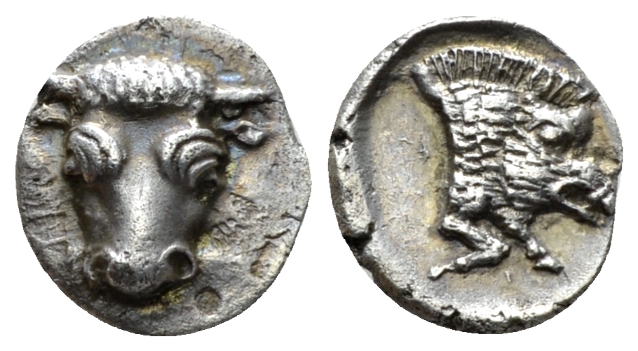S 1921 - Phocis (various mints) (Phocian League), silver, obols (460-400 BCE)
From SILVER
460 BCE - 400 BCE Silver 763 kg
Description
| ObverseInscription or printing placed on the obverse.: | Facing bull's head, the hair shown as lines |
| ReverseInscription or printing placed on the reverse.: | Boar forepart to r. in incuse square, both legs showing, the hide indicated by coarse horizontal strokes. The truncation is curved |
Mint and issuing power
| MintIdentifies the place of manufacture or issue of a numismatic object.: | Phocis (various mints) | Ancient regionAncient region.: | Phocis | Modern countryModern country: Greece | AuthorityIdentifies the issuing power. The authority can be "pretended" when the name or the portrait of X is on the coin but he/she was not the issuing power. It can also be "uncertain" when there is no mention of X on the coin but he/she was the issuing power according to the historical sources: | Phocian League |
Chronology
| FromIdentifies the initial date in a range assigned in a numismatic context. | 460 BCE | toIdentifies the final date in a range assigned in a numismatic context.. | 400 BCE | PeriodTime period of the numismatic object.: Classical 480-323 BC |
Physical description
| MetalThe physical material (usually metal) from which an object is made.: | Silver |
Median weightMedian of the weights of numismatic objects (in grams). in grams | 1.00 | DenominationTerm indicating the value of a numismatic object. Examples: tetradrachm, chalkous, denarius.: | obol |
StandardStandard.: |
Image

S1921 Phocis obols Gr. III-IV.jpg [1]
References
| Die study referencePublication of the study: | Williams 19721Williams 1972, p. 99, 106-107, 112, 113-116, n° 173-179, 220-233, 260, 266-290 (Periods III-IV) | ||
| Coin series referenceReference to coin series study: | Sear I2Sear I, n° 2351, HGC 43HGC 4, n° 1158 | ||
| Coin series web referenceCoin series web references: | |||
Obverse dies distribution
| FrequencyFrequency of specimen in distribution. ᵖ | Number of obversesNumber of obverse dies. ᵖ (o) | % (o) | Number of coinsNumber of coins. (n) | % (n) | Die nameName(s) of the die(s). |
| 1 | 14 | 48.28 | 14 | 17.28 | 127, 157, 162, 184, 195, 197, 200, 201, 203, 204, 206, 207, 208, 209 |
| 2 | 5 | 17.24 | 10 | 12.35 | 123, 124, 193, 199, 205 |
| 3 | 1 | 3.45 | 3 | 3.7 | 192 |
| 4 | 3 | 10.34 | 12 | 14.81 | 125, 161, 196 |
| 5 | 2 | 6.9 | 10 | 12.35 | 126, 198 |
| 6 | 1 | 3.45 | 6 | 7.41 | 159 |
| 8 | 2 | 6.9 | 16 | 19.75 | 160, 191 |
| 10 | 1 | 3.45 | 10 | 12.35 | 158 |
| Total | 29 of 29 | 100.01 | 81 of 81 | 100 |
Reverse dies distribution
no distribution is available
Quantification
| Number of obversesNumber of obverse dies. ᵖ (o) | 29 | Number of singletons (o1)The number of singleton coins. ᵖ | 14 |
| Number of reverse diesNumber of reverse dies. (r) | Number of coinsNumber of coins. (n) | 81 | |
| Coins per obverse dieNumber of coins per obverse die. (n/o) | 2.79 | Coins per reverse dieNumber of coins per reverse die. (n/r) | |
| Reverse per obverse ratioRatio of obverse dies divided by reverse dies. (r/o) | Percentage of singletons (o1)number of coins (n) divided by the number of singletons (o1) ᵖ | 48.28 % | |
| Original number of dies (O) (Carter 1983 formula)The estimation of the number of coins according to Carter 1983 ᵖ | 38.15 | Coins struck if 20,000 as average productivity per dieCoins made if the average productivity for obverses (according to Carter) is 20,000. ᵖ | 763,000 |
| Original number of dies (O) (Esty 2011 formula)The estimation of the number of coins according to the singleton formula in Esty 2011 ᵖ (O) | 45.17 | Survival rate if 20,000 as average productivity per dieSurvival rate if average productivity is 20,000. ᵖ | 0.00011 |
| Coverage (o = % of O) (Esty 1984 formula)Esty 1984 - coverage (% of O) ᵖ (o = % of O) | 82.72% | Die productivity if survival rate 1/2,000Average productivity if survival rate is 1/2,000. ᵖ | 4,246.4 |
| Weight of silver (in kg) if 20,000 coins per die (O = Carter formula)Carter 1983 * Median weight * 20000 (*10 if gold or electrum) ᵖ | 763 kg <br /> 763 kg | Die productivity if survival rate 1/5,000Average productivity if survival rate is 1/5,000. ᵖ | 10,615.99 |
Remarks
Most likely one single workstation There also a few half obols (n° 270: O194; n° 283: O202; n° 291-294: O210-212; 296-298:O214-216)